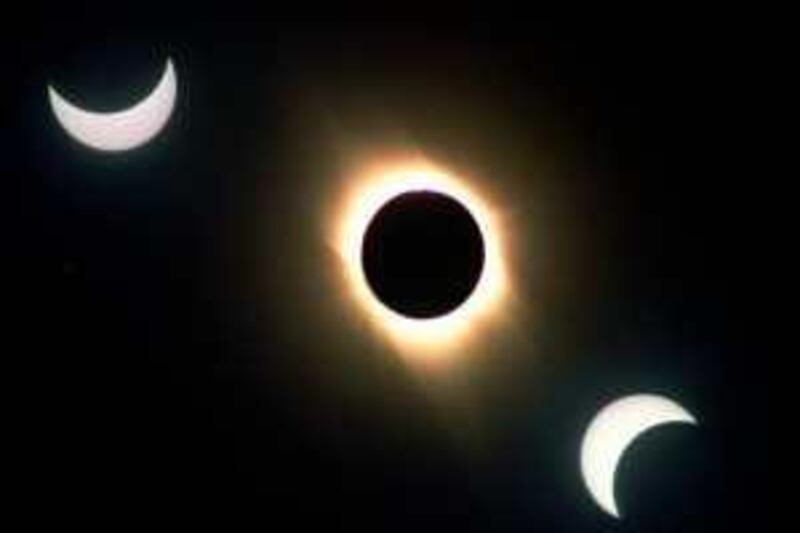Once upon a time, 4.6 billion years ago, something was brewing in an unremarkable backwater of our galaxy, the Milky Way. The ragbag of stuff that suffuses the inconsequential, in-between bits of all galaxies - hydrogen and helium gas with just a sprinkling of dust - had begun to condense. Unable to resist its own weight, part of this newly formed molecular cloud collapsed in on itself. In the ensuing heat and confusion, a star was born - our sun.
We don't know exactly what kick-started this process. Perhaps, with pleasing symmetry, it was the shock wave from the death throes of a nearby star. It was not, at any rate, a particularly unusual event. It had happened countless times since the Milky Way itself came into existence about 13 billion years ago, and in our telescopes we can see it still going on. As stars go, the sun is nothing out of the ordinary.
And yet, as far as we know, it is unique. From a thin disc of stuff left over from its birth, eight planets formed, trapped in orbit by its gravity. One of those planets settled into a peculiarly tranquil relationship with its star and its fellow planets. Eventually, creatures emerged on it that began to wonder how their neighbourhood came to be as it is - and could formulate the following six enduring mysteries of our familiar, and yet deeply mysterious, solar system.
It is one of the most glorious pieces of natural theatre. A total solar eclipse is worth the wait because the fit of Sun and Moon is so perfect that beads of sunlight can only reach us through the rugged valleys on the lunar surface, creating the stunning "diamond ring" effect. It is all thanks to a striking coincidence. The Sun is about 400 times as wide as the Moon, but it is also 400 times further away. The two therefore look the same size in the sky - a unique situation among our solar system's eight planets and 166 known moons. Earth is also the only planet to harbour life. Pure coincidence? Almost undoubtedly, say most astronomers.
Our moon is large relative to Earth's own size and scientists believe there can be only one explanation: in the first 100 million years of the solar system, a Mars-sized object smashed into Earth. That impact radically remodelled our planet, expelling a huge amount of debris that eventually congealed into our oversized Moon. Such a big moon is a big boon for life on Earth. As Earth spins on its own axis, it has a natural tendency to wobble, owing to the varying pull on it from other bodies such as the Sun. The unseen hand of the Moon's gravity gently damps that wobble, preventing instabilities which would otherwise have caused dramatic changes in Earth's climatic zones over time.
In 1066, as just one example, a comet's appearance was seen as a portent of doom before the Battle of Hastings. Modern science takes a more measured view. Comets are agglomerations of dust and ice that orbit the sun on highly elliptical paths, acquiring their spectacular tails in the headwind of charged particles streaming from the sun. We even know their source: they are Kuiper belt objects, icy bits of debris that pepper space from Neptune's orbit.
But there's a problem. Certain comets, such as Hale-Bopp, which flashed past Earth in 1997, appear so infrequently that their orbits must be very long, far too long to have an origin in the Kuiper belt. The conclusion of many astronomers is that the known solar system is surrounded by a tenuous halo of icy outcasts, thrown from the Sun's immediate vicinity billions of years ago by the gravity of the giant planets.
Lurking in the solar system's dark recesses, rumour has it, is an unsighted world - Planet X, a frozen body perhaps as large as Earth. Planet X would be the most significant addition to the solar system since the discovery of Pluto, the now notorious non-planet, in 1930. When the International Astronomical Union voted to downgrade Pluto to dwarf planet status in 2006, they established three criteria for a fully blown planet: it must orbit the Sun; its gravity must suffice to mould it into a near-spherical shape; and it must be massive enough to have ploughed its orbit clear of other bits and bobs. Pluto falls down on this third point. It is just one of many Kuiper belt objects. Any new object would have to be well clear of the Kuiper belt to qualify as a planet. Yet intriguingly, it is studies of the belt that have suggested the planet's existence. Some Kuiper belt objects travel in elongated orbits around the sun. Others have steep orbits almost at right angles to the orbits of all the major planets. "Those could be signs of perturbation from a massive distant object," says Robert Jedicke, at the University of Hawaii.
We live in uninteresting times. Since the ructions that created the planets in the solar system's first 100 million years - and apart from an early migration of the giant planets and the odd colliding comet not swept safely aside by Jupiter - nothing much has really been happening. Our Sun will die, of course, about six billion years from now. But things could get ugly long before that. The steady gyrations of the solar system today may conceal the seeds of chaos. Even the tiniest of irregularities can build up over time, gradually altering the paths of the planets. Between now and final sundown, it has been calculated, there is a roughly two per cent chance of catastrophe. Mars might drift too close to Jupiter and be thrown out of the solar system. If we're very unlucky, hot-headed Mercury could run wild and smash into Earth.
Meanwhile, the Sun will slowly get brighter. Within 2 billion years, its heat will probably kill off life on Earth's surface. Mars, on the other hand - if it is still there - should gain a cosier climate. When the Sun's core burns up the last of its hydrogen fuel, the whole structure of the star will radically rearrange. It will slowly bloat to more than a million times its present volume, becoming a red giant. That giant will swallow Mercury and Venus and, according to the latest simulations, probably Earth too.
* www.newscientist.com






